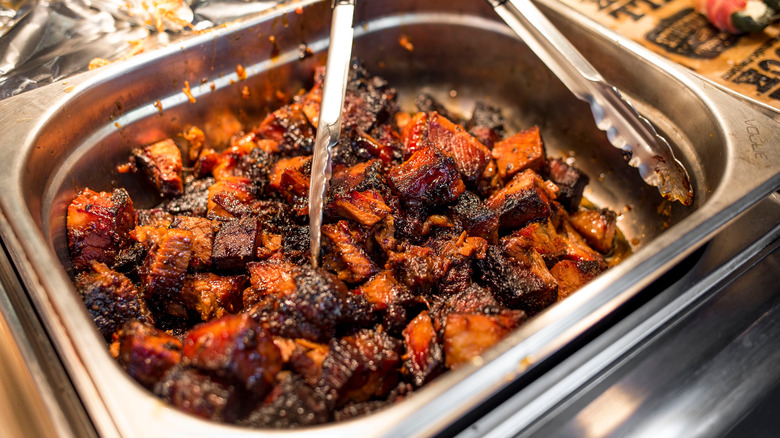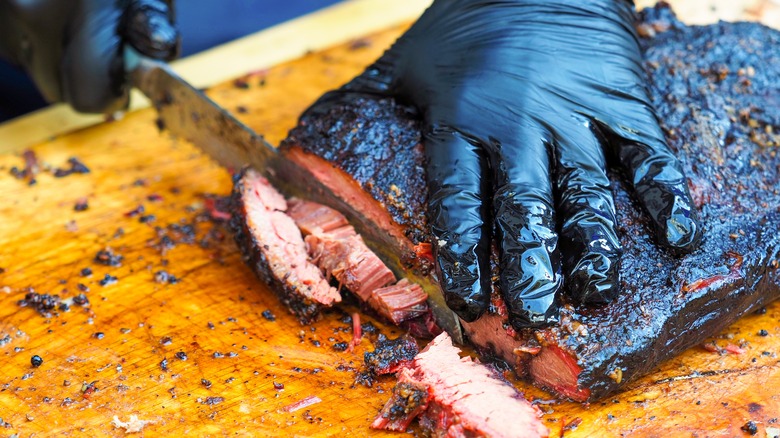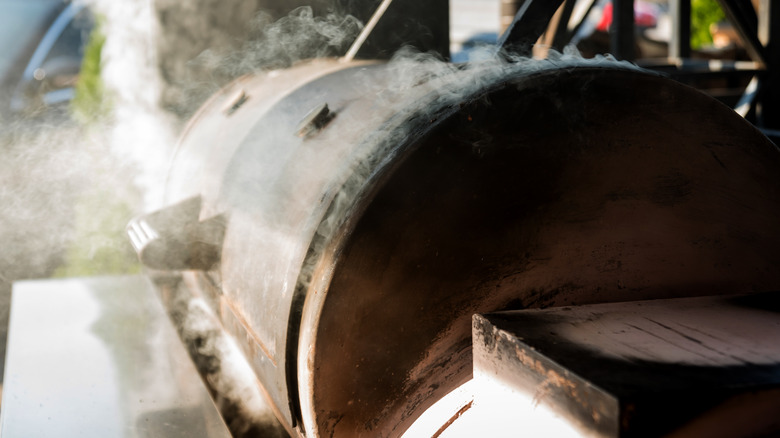The Best Cut Of Meat For Making Burnt Ends
One of the tastiest treats you can enjoy when visiting Kansas City is a big container of burnt ends. This underrated dish doesn't always make an appearance on a barbecue joint's menu, so it's worth nabbing when you see it. The sweetly caramelized bites of meat are rich with melty fat and a smoky, savory flavor. While its deliciousness is unquestionable, those who are new to this regional specialty may wonder how it's made and, more importantly, what it's made out of.
Traditionally, this dish is comprised of the literal burnt ends of a slab of brisket. The large slab of beef, which spends hours cooking in a smoker, has thinner edges that cook through more quickly. These end pieces eventually become deeply blackened, with a crispy texture and slightly sweet, deeply meaty taste. The odds and ends of each portion of brisket are cut into small bits and eaten alone, or doused in some of the Kansas City's iconic sweet BBQ sauce for some added moisture. Though modern restaurants also make burnt ends out of other cuts of beef or even pork, many barbecue aficionados argue that brisket is the absolute best (and only!) meat for the job.
A brief history of burnt ends
Kansas City has a long and proud history of barbecue culture, and beef brisket is a well-respected staple. KC-style BBQ makes use of both the flat and the point, two areas of the cut that have different textures. The leaner flat is often sliced and served with plenty of sauce and white bread. The point, also known as the deckle, has a ton of fat that renders and caramelizes as it cooks, and it's this part that's used to make burnt ends. However, these bite-size treats weren't always so coveted — in fact, they used to be thrown away.
For many years, barbecue pit masters would cut off and toss the burnt bits of their brisket before serving up the rest to customers. However, at the famous Arthur Bryant's, the restaurant credited as the first to serve burnt ends, workers began giving the crispy edges away for free. A magazine article about the restaurant, which mentioned those amazingly tasty ends, caused demand for the delicious burnt bites to skyrocket. They soon landed an official spot on the menu.
Today, hungry visitors can order burnt ends at establishments across Kansas and Missouri, as well as some BBQ joints in other states. Modern approaches to the dish often deviate from the original recipe. Some restaurants use the entire brisket to make burnt ends, simply smoking the whole slab twice to mimic that trademark crispy texture.
Tips for making burnt ends at home
To capture the beauty of burnt ends, you need a great bark. Bark refers to the blackened exterior that meat develops in the smoker. It's really a layer of build-up from the combo of aromatic wood smoke, spice rubs, and moisture. To produce a brag-worthy bark on homemade burnt ends, you'll need to devote a whole day to smoking the brisket. Start by covering the beef with a smoky spice rub, then smoke it, cut it up into small squares, toss with BBQ sauce, and return the ends to the smoker to caramelize. Oak and hickory wood are the traditional choices for this dish.
While brisket may be the most authentic choice, other meats will still produce tasty results. After all, brisket is no longer the inexpensive budget cut it once was. Clever backyard grill masters have come up with "poor man's" burnt ends recipes, which often feature chuck roast. To scrimp even more, some cooks smoke and season hot dogs to replicate the taste and texture of burnt ends. You can more or less use the same prep method on these alternative cuts.
Even non-beef options like fatty pork belly or pork butt will take on a nice bark in the smoker and make for tasty burnt ends. Vegetarians can even apply the technique to tofu, though the final result will lack the lusciousness of rendered fat. Kansas City natives might not see these non-brisket dishes as authentic, but we won't tell.



